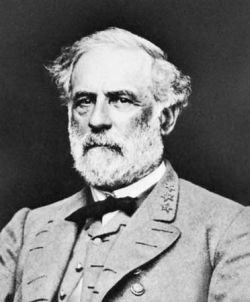 Confederate Gen. Robert E. Lee‘s invasion of Pennsylvania today meets resistance in the town of Hanover.
Confederate Gen. Robert E. Lee‘s invasion of Pennsylvania today meets resistance in the town of Hanover.
The encounter begins when Confederate Major Gen. J.E.B. Stuart’s cavalry attacks a Union cavalry regiment and forces the federal forces to retreat through the streets of Hanover. The Confederate retreat, however, proves to be momentary. A brigade arrives to reinforce the Union cavalry, and a stalemate ensures.
Stuart’s orders had been to rejoin Lee’s army west of the town of Gettysburg. Stuart eventually withdraws from the standoff in Hanover and detours north and east towards York County, further delaying his rendezvous with Lee. While passing through the county on the morning of July 1, Stuart seizes some 1,000 fresh horses from local farmers.
Some of the farmers forced to give up their horses are German Baptists, also known as Dunkers. Among the earliest setters of the county, these Baptists meet at the Dover Baptist Church in the town of Dover. An “early clergyman” among the region’s German Baptists recalled the history of the group:
About the close of the eighteenth century, a number of members of this settlement came to York County, who believed that the doctrine of immersion of a believer in water was necessary to constitute Christian baptism, and wrote to the Vincent Baptist Church of Chester County, desiring that church to send a person properly qualified to baptize them. This request was granted, and eight were baptized in the name of the “Triune God.” In 1804, another minister of the gospel visited them and baptized a few others in the adjoining stream. An organization was then effected. The congregation had a regular pastor for a term of but four years, and for nearly half a century later was occasionally visited by different clergymen. The membership at one time increased to fifty, under the Rev. Henry Essick, who came there from Delaware County in 1842.
Thus some of Stuart’s cavalrymen ride to Gettysburg on German Baptist horses, a small town where the course of the war, and the future of a broken nation, are destined to be converge.
Sources: Battle of Hanover (link); John Gibson, Editor, History of York County, Pennsylvania. Chicago: F. A. Battey Publishing Co., 1886, p. 693 (link)


